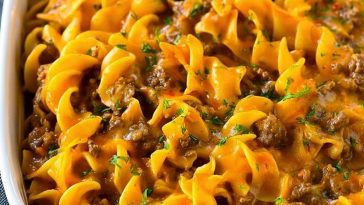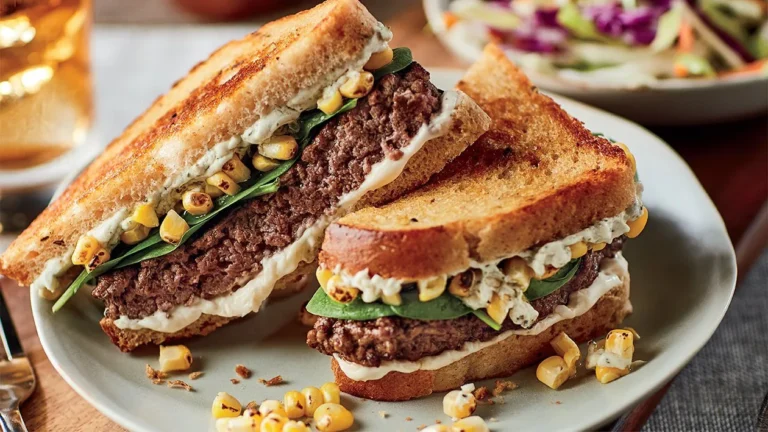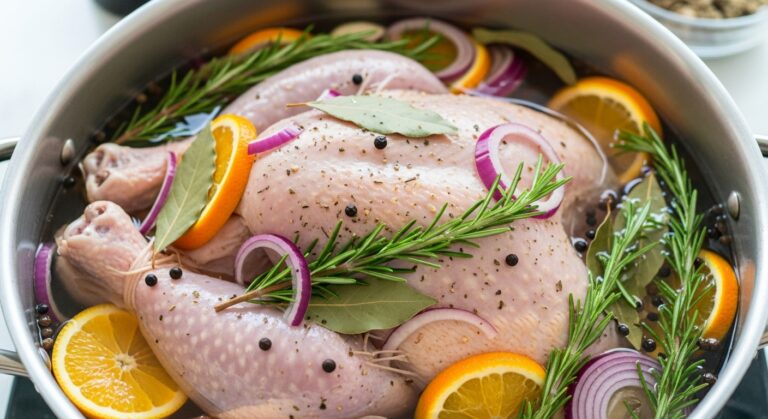Slow Cooker Korean Style Pot Roast (Set It & Forget It!)
Tender, flavorful, and infused with bold Asian-inspired seasonings, Korean Style Pot Roast is the ultimate fusion comfort food with an exciting twist. This show-stopping dish features a succulent beef roast slow-cooked in a savory-sweet sauce made with soy sauce, gochujang, ginger, and garlic, all braised until fall-apart tender with aromatic vegetables. It’s the kind of meal that fills the whole house with incredible aromas and draws everyone straight to the table.
Each slice delivers a mouthwatering combination of textures—melt-in-your-mouth beef, caramelized vegetables, and perfectly balanced with spicy, sweet, and umami-rich flavors. Whether you’re cooking for a special Sunday dinner or impressing guests with something unique, this pot roast is as impressive to serve as it is to love. Add your favorite accompaniments like steamed rice, pickled radish, sesame seeds, or fresh scallions for a colorful, customizable meal that feels like a Korean-American fusion celebration.
Why You’ll Love This Korean Style Pot Roast
- Fusion comfort perfection: Classic American pot roast meets Korean flavors for the best of both worlds.
- Incredibly tender meat: Low and slow cooking transforms tough cuts into fork-tender, succulent perfection.
- Bold, complex flavors: Gochujang, soy sauce, and aromatics create layers of sweet, spicy, and savory depth.
- Perfect for entertaining: Impressive presentation with minimal active cooking time during the day.
- Fantastic leftovers: The flavors deepen overnight, making it even better the next day.
Preparation Phase & Tools to Use (Essential Tools and Equipment, Plus Why They Matter)
Before diving into this delicious Korean Style Pot Roast, having the right tools on hand will make everything smoother—from prep to clean-up.
Essential Tools & Why You Need Them:
Large Dutch Oven or Heavy Pot (6-quart)
This is the MVP of the recipe. It distributes heat evenly for perfect braising and goes from stovetop to oven seamlessly.
Tongs
Essential for handling the large roast when searing and transferring without piercing the meat.
Sharp Chef’s Knife
Perfect for trimming excess fat, slicing vegetables, and carving the finished roast.
Cutting Board
For safely preparing the roast, vegetables, and aromatics efficiently.
Measuring Cups & Spoons
Precision matters—especially for the gochujang and soy sauce ratios to achieve authentic Korean flavor balance.
Meat Thermometer
Best for ensuring the roast reaches perfect tenderness without guessing.
Ladle or Large Spoon
Ideal for basting the roast and serving the rich, flavorful sauce.
Having these items prepped and within reach makes the cooking process seamless and safe.
Preparation Tips
- Sear the roast on all sides for deep, caramelized flavor—this crucial step shouldn’t be skipped.
- Bring the roast to room temperature 30–45 minutes before cooking for more even results.
- Use a good quality chuck roast with marbling for maximum tenderness and flavor.
- Don’t skip the aromatics—ginger, garlic, and scallions are essential for authentic Korean taste.
- Let the roast rest for 15 minutes after cooking so juices redistribute throughout the meat.
- Skim excess fat from the sauce before serving for a cleaner, more refined finish.
These small touches make a big difference in taste, texture, and presentation.
Ingredients for This Korean Style Pot Roast
Here’s everything you’ll need to bring this bold, flavor-packed roast to life. Most of the ingredients are Asian pantry staples mixed with pot roast essentials.
For the Beef Roast:
- 3–4 lbs beef chuck roast
- 2 tablespoons vegetable oil
- 1 teaspoon salt
- 1 teaspoon black pepper
- 2 tablespoons all-purpose flour (for dusting)
For the Korean Braising Sauce:
- ½ cup soy sauce
- ¼ cup gochujang (Korean chili paste)
- ¼ cup brown sugar
- ¼ cup rice wine or mirin
- 2 cups beef broth
- 6 cloves garlic, minced
- 2-inch piece fresh ginger, minced
- 2 tablespoons sesame oil
- 1 tablespoon gochugaru (Korean chili flakes) – optional
- 1 tablespoon apple cider vinegar
For the Vegetables:
- 1 large onion, cut into wedges
- 3 large carrots, cut into 2-inch pieces
- 4 medium potatoes, quartered
- 1 daikon radish, cut into chunks (or regular radishes)
- 6 scallions, white parts cut into 2-inch pieces
Optional Garnishes:
- Toasted sesame seeds
- Sliced scallions
- Fresh cilantro
- Korean pickled radish (danmuji)
- Kimchi
- Steamed white rice
Everything in this list balances traditional pot roast with Korean flavors—the gochujang and soy create depth while vegetables add hearty substance. The garnishes are optional but give the dish an authentic, restaurant-quality finish.
Step 1: Prepare and Sear the Roast
Pat the chuck roast completely dry with paper towels. Season all sides generously with salt and pepper, then dust lightly with flour. Heat vegetable oil in a large Dutch oven over medium-high heat. Once the oil is shimmering, sear the roast on all sides until deeply browned, about 4–5 minutes per side. Remove the roast and set aside on a plate.
Step 2: Build the Sauce Base
Reduce heat to medium. In the same Dutch oven, add the minced garlic and ginger, sautéing for 1 minute until fragrant. Add the soy sauce, gochujang, brown sugar, rice wine, sesame oil, gochugaru (if using), and apple cider vinegar. Whisk everything together until the gochujang is fully dissolved and the sauce is smooth. Pour in the beef broth and stir to combine.
Step 3: Add Roast and Initial Vegetables
Return the seared roast to the Dutch oven. Add the onion wedges and white parts of the scallions around the roast. Spoon some of the sauce over the top of the meat. Bring the liquid to a gentle simmer.
Step 4: Braise in the Oven
Preheat your oven to 325°F (165°C). Cover the Dutch oven with a tight-fitting lid and transfer to the oven. Braise for 2½ hours, basting the roast with the sauce every 45 minutes if possible. The roast should be getting very tender.
Step 5: Add Remaining Vegetables
After 2½ hours, carefully remove the Dutch oven from the oven. Add the carrots, potatoes, and daikon radish, nestling them into the braising liquid around the roast. Cover and return to the oven for another 45–60 minutes, or until the vegetables are tender and the roast is fork-tender and easily shreds.
Step 6: Rest and Serve
Remove the Dutch oven from the oven. Transfer the roast to a cutting board and tent with foil. Let it rest for 15 minutes. Meanwhile, skim any excess fat from the surface of the sauce. Slice or shred the roast against the grain. Arrange on a serving platter with the vegetables, ladle the sauce over everything, and garnish with sesame seeds, sliced scallions, and cilantro as desired. Serve hot with steamed rice.
Notes
Slow Cooker Method: Sear the roast, add everything to a slow cooker, and cook on LOW for 8–10 hours. Add vegetables during the last 2 hours.
Spice Level Control: Reduce or omit the gochujang and gochugaru for a milder version. The dish will still be flavorful.
Make It a Complete Meal: Serve with steamed rice, kimchi, and pickled vegetables for an authentic Korean spread.
Watch Out for These Mistakes While Cooking
- Not searing the roast properly: Proper browning on all sides develops essential flavor. Don’t rush this step.
- Using a roast that’s too lean: Chuck roast with marbling is ideal. Lean cuts like eye of round dry out during long cooking.
- Opening the oven too frequently: Each time you open the oven, you lose heat and extend cooking time. Limit basting to 2–3 times maximum.
- Adding vegetables too early: Vegetables become mushy if added at the beginning. Add them during the last hour.
- Not bringing meat to room temperature: Cold meat from the fridge cooks unevenly. Let it sit out for 30–45 minutes first.
- Forgetting to skim the fat: Excess fat makes the sauce greasy. Always skim before serving.
- Slicing with the grain: Always slice against the grain for the most tender, easy-to-chew pieces.
- Not letting the roast rest: Slicing immediately causes all the juices to run out. Patience is rewarded with juicier meat.
What to Serve With Korean Style Pot Roast?
This rich, flavorful pot roast is substantial on its own, but pairing it with the right sides can elevate it into a complete Korean-inspired feast. Whether you’re going traditional or creative, there’s a side dish for every preference.
8 Delicious Recommendations:
Steamed White Rice
Fluffy jasmine or short-grain rice is essential for soaking up the incredible Korean-style sauce.
Kimchi
Spicy, fermented kimchi provides tangy, probiotic goodness and authentic Korean flavor.
Korean Pickled Radish (Danmuji)
Sweet, crunchy pickled radish offers refreshing contrast to the rich roast.
Seasoned Spinach (Sigeumchi Namul)
Lightly seasoned spinach with sesame oil adds a healthy, traditional Korean side.
Korean Cucumber Salad
Cool, tangy cucumber slices with vinegar and sesame refresh the palate beautifully.
Japchae (Glass Noodles)
Sweet potato noodles with vegetables create an impressive, restaurant-style presentation.
Miso Soup
Light, warming soup provides a comforting start to the meal.
Bingsu or Rice Cakes (for dessert)
A sweet Korean dessert rounds out the fusion feast perfectly.
These pairings help round out the meal and bring a restaurant-level feel to your dinner table.
Storage Instructions
Korean Style Pot Roast is even better the next day—and it stores beautifully.
How to Store:
Refrigerator: Let the roast cool completely, then transfer meat, vegetables, and sauce to airtight containers. It will keep in the fridge for up to 4 days.
Freezer: For longer storage, wrap the cooled roast and sauce (vegetables separate) tightly in plastic wrap and then foil, or place in freezer-safe containers. Freeze for up to 3 months.
Reheating:
Oven: Reheat at 325°F (165°C), covered with foil, with a splash of broth for 30–40 minutes or until heated through.
Stovetop: Slice the roast and reheat gently in the sauce over medium-low heat for 10–15 minutes.
Microwave: Heat individual portions on medium power for 3–4 minutes, stirring halfway through.
Always ensure internal temperature reaches 165°F (74°C) when reheating.
Estimated Nutrition (Per Serving – Based on 6 Servings)
Please note this is an approximate breakdown and may vary based on exact ingredients used.
| Nutrient | Amount Per Serving |
|---|---|
| Calories | 485 |
| Protein | 42g |
| Carbohydrates | 38g |
| Dietary Fiber | 5g |
| Sugar | 12g |
| Total Fat | 18g |
| Saturated Fat | 6g |
| Unsaturated Fat | 11g |
| Trans Fat | 0g |
| Cholesterol | 130mg |
| Sodium | 1240mg |
This dish delivers a satisfying balance of protein, carbs, and fats—great for a hearty lunch or dinner with energy to spare.
Frequently Asked Questions
1. Can I make Korean Style Pot Roast ahead of time?
Absolutely. Make it 1–2 days ahead and refrigerate. The flavors actually improve as they meld. Reheat gently before serving.
2. Can I use a different cut of beef?
Chuck roast is ideal, but brisket or short ribs also work wonderfully. Avoid lean cuts like sirloin as they dry out.
3. Is this dish very spicy?
The base recipe has medium heat from gochujang. Control the spice by adjusting the amount or omitting gochugaru.
4. Can I make this without gochujang?
Gochujang is essential for authentic Korean flavor, but you can substitute with a mix of sriracha, miso paste, and a pinch of sugar.
5. What if I don’t have a Dutch oven?
Use any oven-safe pot with a tight-fitting lid, or sear the roast in a skillet and transfer everything to a roasting pan covered tightly with foil.
6. Can I double this recipe for a larger group?
Yes, but use a larger pot or roasting pan. The cooking time remains approximately the same since the roast size doesn’t double.
7. Can I make this in an Instant Pot?
Definitely. Sear using the sauté function, add ingredients, pressure cook on high for 60–75 minutes, then natural release for 15 minutes.
8. How do I know when the roast is done?
It should be fork-tender and easily shred. Internal temperature should reach at least 190–200°F for pot roast tenderness.
Conclusion
Korean Style Pot Roast is the ultimate combination of classic comfort and bold Asian flavor—all braised into one tender, satisfying dish. With its melt-in-your-mouth beef, savory-sweet Korean sauce, and hearty vegetables, it’s everything you love about pot roast, elevated with exciting new flavors.
Perfect for Sunday dinners, special occasions, or impressive entertaining, this pot roast is as versatile as it is delicious. Plus, with endless side dish options, it creates a memorable feast every time. So grab your Dutch oven and make dinner something everyone looks forward to.






